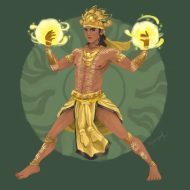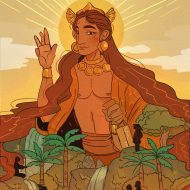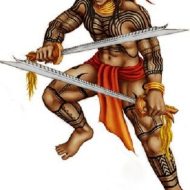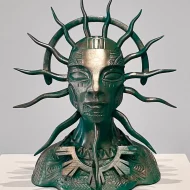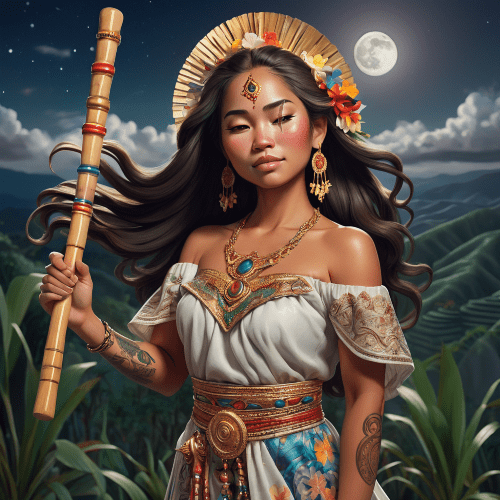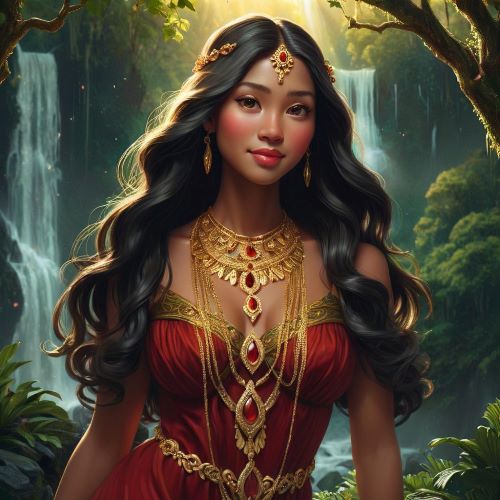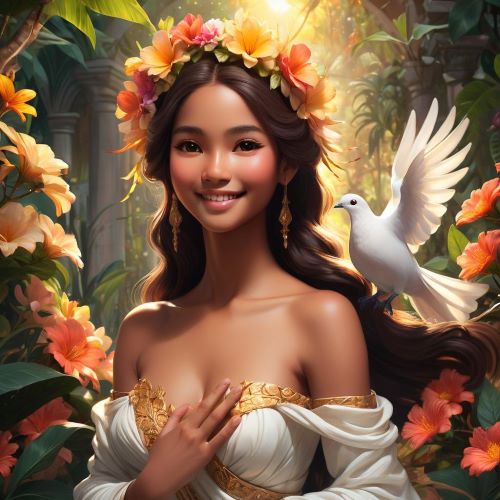Apolaki : The Sun God
Listen
At a glance
| Description | |
|---|---|
| Origin | Philippine Mythology |
| Classification | Gods |
| Family Members | Bathala (Father), Mayari (Sister) |
| Region | Philippines |
| Associated With | Sun |
Apolaki
Introduction
In the rich tapestry of Philippine mythology, few figures shine as brightly as Apolaki, the god of the sun and patron of warriors. Revered across Tagalog and Visayan traditions, Apolaki embodies the dual nature of light: nurturing life with warmth and radiance while commanding immense power in warfare. His name itself, derived from the Tagalog word Apó meaning “elder” or “ancestor,” reflects his respected status as a divine protector and guide.
For pre-colonial Filipinos, Apolaki was not only a celestial being but also a source of sustenance and courage. His daily journey across the sky symbolized the eternal cycle of vitality and renewal, essential for crops, communities, and spiritual balance. At the same time, his reputation as a god of war captured the spirit of resilience and bravery deeply rooted in Filipino culture. Worship of Apolaki was woven into rituals, oral traditions, and the very fabric of daily life, ensuring his influence endured for centuries.
Physical Traits
Depictions of Apolaki emphasize his radiant connection to the sun. He is often described as a strikingly handsome young man with golden skin and glowing hair, radiating the brilliance of the midday sun. His divine attire consists of garments woven with gold, shining like the horizon at dawn.
Apolaki is never far from the symbols of his dual role. In one hand, he carries a shield, a reminder of his protective strength against forces of chaos and harm. In the other, he wields a spear, whose sharp rays symbolize the piercing light of the sun as well as the might of a warrior on the battlefield. Some myths also describe him driving a golden chariot, marking the sun’s daily journey across the heavens. His presence is said to leave behind a halo of light that warms the earth and illuminates the path for humanity.
Family
Apolaki’s lineage ties him directly to Bathala, the supreme god of the Tagalog pantheon, and a mortal woman. This parentage highlights his role as a bridge between the divine and mortal realms, giving him both cosmic authority and human relatability. His siblings include Mayari, the goddess of the moon, and Tala, the goddess of the stars, creating a celestial family that governs the heavens.
The most enduring myth about Apolaki involves his conflict with Mayari. After Bathala’s passing, the siblings quarreled over rulership of the earth. Apolaki desired sole dominion, while Mayari argued for equal rule. Their disagreement escalated into a violent clash, during which Apolaki struck Mayari and injured one of her eyes. Overcome with remorse, Apolaki relented and agreed to share power. From this reconciliation, Apolaki took rulership of the day while Mayari governed the night. The myth explains why the sun shines brighter than the moon: Apolaki retains his full vision, while Mayari’s light is dimmed by her injury. This story not only offers a cosmic explanation for natural phenomena but also reflects deeper cultural themes of equality, justice, and reconciliation.
Other names
Though widely known as Apolaki, variations of his name and worship existed across the Philippine archipelago. Among the Tagalog and Visayan people, he was recognized primarily as a solar and warrior deity. His name’s root, Apó, suggests reverence for ancestors and elders, linking his myth to indigenous practices of ancestral worship. It is important not to confuse Apolaki with Malayari, a different deity from the Sambal people with his own mythology.
Powers and Abilities
Apolaki embodies a powerful duality as both the god of the sun and the god of war. His solar aspect connects him to the daily cycle of life, health, and prosperity. His rays were believed to nurture crops, heal the sick, and chase away evil spirits lurking in darkness. Communities turned to him for blessings of good harvests and protection from plagues, viewing his light as a divine shield over the land.
On the battlefield, Apolaki’s warrior side shone just as brightly. Warriors invoked his name for strength, courage, and protection, believing that his radiant energy would flow through them in combat. His spear represented not only sunlight but also the sharp decisiveness needed in war. As a war god, Apolaki was a patron of valor and honor, embodying the martial spirit that defined many pre-colonial Filipino societies.
The combination of these aspects underscores his role as a protector and provider. His dual nature reflects the balance of creation and destruction, peace and conflict—an eternal truth in both myth and human life.
Modern Day Influence
In modern times, Apolaki has seen a revival as part of a broader resurgence of interest in Philippine mythology. For centuries, Spanish colonization suppressed indigenous belief systems, merging or erasing many deities through the introduction of Christianity. Yet, Apolaki’s image as both sun god and warrior survived in oral traditions, folk stories, and cultural memory.
Today, artists, writers, and cultural groups are reinterpreting Apolaki as a symbol of Filipino identity and resilience. His myths are retold in literature, comics, and online platforms, often highlighting his role in the story with Mayari as a reflection of gender equality and shared power. In festivals and heritage events, Apolaki’s presence reminds Filipinos of their pre-colonial roots and the strength embedded in their ancestral traditions.
Moreover, Apolaki has become a popular figure in contemporary media and fantasy works. From being reimagined in video games and graphic novels to appearing in modern retellings of myths, he continues to inspire new generations. His story resonates not only as an explanation of cosmic phenomena but also as a timeless narrative about courage, remorse, and reconciliation.
In the Philippines’ ongoing journey to reclaim and celebrate indigenous heritage, Apolaki’s light shines as brightly as ever. His myth embodies both strength and humility, a reminder that power must always be balanced with responsibility and compassion.
Related Images
Sources
Philippine Arts Council. (2022, May 31). Apolaki (God of the Sun). Retrieved from https://www.philippineartscouncil.com/post/apolaki-god-of-the-sun
Acaballz. (2025, June 27). Apolaki, God of the Sun and War. Retrieved from https://acaballz.com/blogs/blog/apolaki-god-of-the-sun-and-war
Gods and Monsters Info. (2024, July 15). Myth of the Day: Apolaki. Retrieved from https://godsandmonstersinfo.substack.com/p/myth-of-the-day-apolaki
Tumblr. (n.d.). Apolaki – The God of the Sun and War. Retrieved from https://www.tumblr.com/pinoy-culture/23312824838/apolaki-the-god-of-the-sun-and-war-apolaki-is-a
Jocano, F. L. (1969). Outline of Philippine Mythology. Centro Escolar University.
Demetrio, F. R. (1990). The Soul Book: Introduction to Philippine Pagan Religion. GCF Books.
Eugenio, D. L. (2001). Philippine Folk Literature: The Myths. University of the Philippines Press.
Frequently Asked Questions
What is Apolaki the god of?
Apolaki is the Filipino god of the sun and war in Tagalog mythology, often revered as a protector and a bringer of light and strength.
What is the story of Apolaki and Mayari?
In Tagalog mythology, Apolaki and Mayari are siblings and deities of the sun and moon. After their father, Bathala, divided the sky, Apolaki became the god of the sun, and Mayari the goddess of the moon. A myth tells of a fierce battle between them over who would rule the day, during which Mayari lost an eye. Afterward, they agreed to share the sky, giving rise to the cycle of day and night.
Who are Apolaki’s parents?
Apolaki is a child of Bathala, the supreme god in Tagalog mythology.
Is Apolaki associated with any animals or symbols?
Apolaki is often linked with the sun and symbols of strength and war, such as the spear or shield.
How is Apolaki worshiped or honored?
Traditionally, Apolaki was honored through rituals, offerings, and prayers to seek protection, courage, and guidance in battle or daily life.


